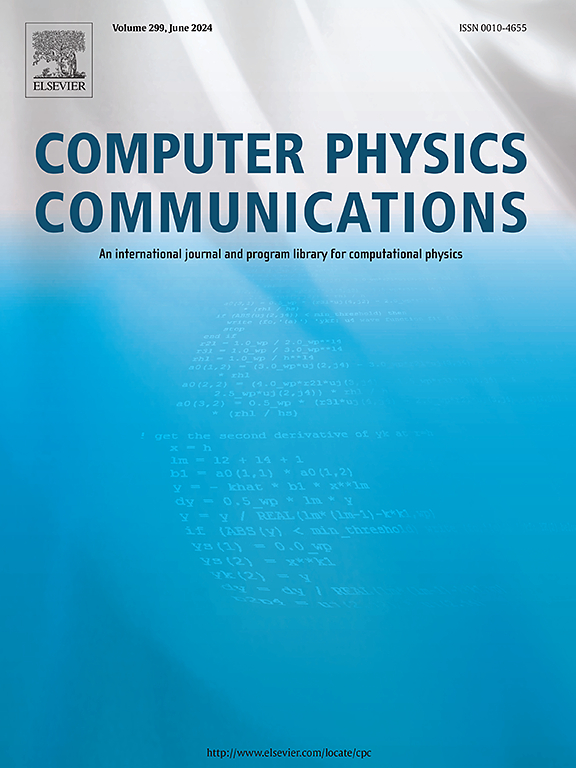A high-performance ray tracing particle tracking model for the simulation of microplastics in inland and coastal aquatic environments
IF 3.4
2区 物理与天体物理
Q1 COMPUTER SCIENCE, INTERDISCIPLINARY APPLICATIONS
引用次数: 0
Abstract
In this study, we present a high-performance Particle Tracking Model (PTM) designed for simulating any type of particles, with a focus on microplastics. The PTM is efficient compared to existing models, parallelized, and utilizes a ray tracing algorithm incorporating both ray reflection and ray refraction in order to traverse particles as well as find the location of each particle over three-dimensional unstructured grids. Various numerical corrections are implemented in the model to address computational round-off errors and discontinuities in the water surface level of the input hydrodynamic models. To increase the accuracy of the model, partially reflective boundary conditions are imposed as well as the capability to simulate microplastics beaching and washout in very shallow areas or dry computational cells. Several tests are conducted to study the performance, scalability, and accuracy of the model. The proposed model is tested with over 3.88 billion double-precision particles on three-dimensional computational grids with up to approximately one million cells. The tests show that the ray tracing approach is efficient, achieves over 17× faster runtime, and offers greater accuracy compared to using an auxiliary grid for particle location finding. For larger timesteps, the ray tracing PTM with refraction shows improved accuracy compared to the ray tracing PTM without refraction. The model's capabilities are tested in a real-world case study over the Saguenay Fjord, Quebec, Canada. The model is utilized to reproduce the paths of five surface drifters. A second numerical test is conducted in the Fjord and high particle concentration areas are identified.
用于模拟内陆和沿海水生环境中微塑料的高性能射线追踪粒子跟踪模型
在本研究中,我们提出了一种高性能粒子跟踪模型(PTM),该模型专为模拟任何类型的粒子而设计,重点是微塑料。与现有模型相比,粒子追踪模型效率高、可并行处理,并采用了包含光线反射和光线折射的光线追踪算法,以便在三维非结构网格上穿越粒子并找到每个粒子的位置。该模型采用了各种数值校正方法,以解决计算舍入误差和输入流体力学模型的水面不连续问题。为了提高模型的准确性,还施加了部分反射边界条件,以及在非常浅的区域或干燥的计算单元中模拟微塑料冲滩和冲刷的能力。为研究模型的性能、可扩展性和准确性,进行了多项测试。在多达约一百万个单元的三维计算网格上,用超过 38.8 亿个双精度粒子对所提出的模型进行了测试。测试结果表明,射线追踪方法非常高效,运行时间比使用辅助网格寻找粒子位置的方法快 17 倍以上,而且精度更高。在更大的时间步长内,与不带折射的射线追踪 PTM 相比,带折射的射线追踪 PTM 显示出更高的精度。该模型的功能在加拿大魁北克萨格奈峡湾的实际案例研究中进行了测试。利用该模型再现了五个水面漂流器的路径。在峡湾进行了第二次数值测试,并确定了高粒子浓度区域。
本文章由计算机程序翻译,如有差异,请以英文原文为准。
求助全文
约1分钟内获得全文
求助全文
来源期刊

Computer Physics Communications
物理-计算机:跨学科应用
CiteScore
12.10
自引率
3.20%
发文量
287
审稿时长
5.3 months
期刊介绍:
The focus of CPC is on contemporary computational methods and techniques and their implementation, the effectiveness of which will normally be evidenced by the author(s) within the context of a substantive problem in physics. Within this setting CPC publishes two types of paper.
Computer Programs in Physics (CPiP)
These papers describe significant computer programs to be archived in the CPC Program Library which is held in the Mendeley Data repository. The submitted software must be covered by an approved open source licence. Papers and associated computer programs that address a problem of contemporary interest in physics that cannot be solved by current software are particularly encouraged.
Computational Physics Papers (CP)
These are research papers in, but are not limited to, the following themes across computational physics and related disciplines.
mathematical and numerical methods and algorithms;
computational models including those associated with the design, control and analysis of experiments; and
algebraic computation.
Each will normally include software implementation and performance details. The software implementation should, ideally, be available via GitHub, Zenodo or an institutional repository.In addition, research papers on the impact of advanced computer architecture and special purpose computers on computing in the physical sciences and software topics related to, and of importance in, the physical sciences may be considered.
 求助内容:
求助内容: 应助结果提醒方式:
应助结果提醒方式:


